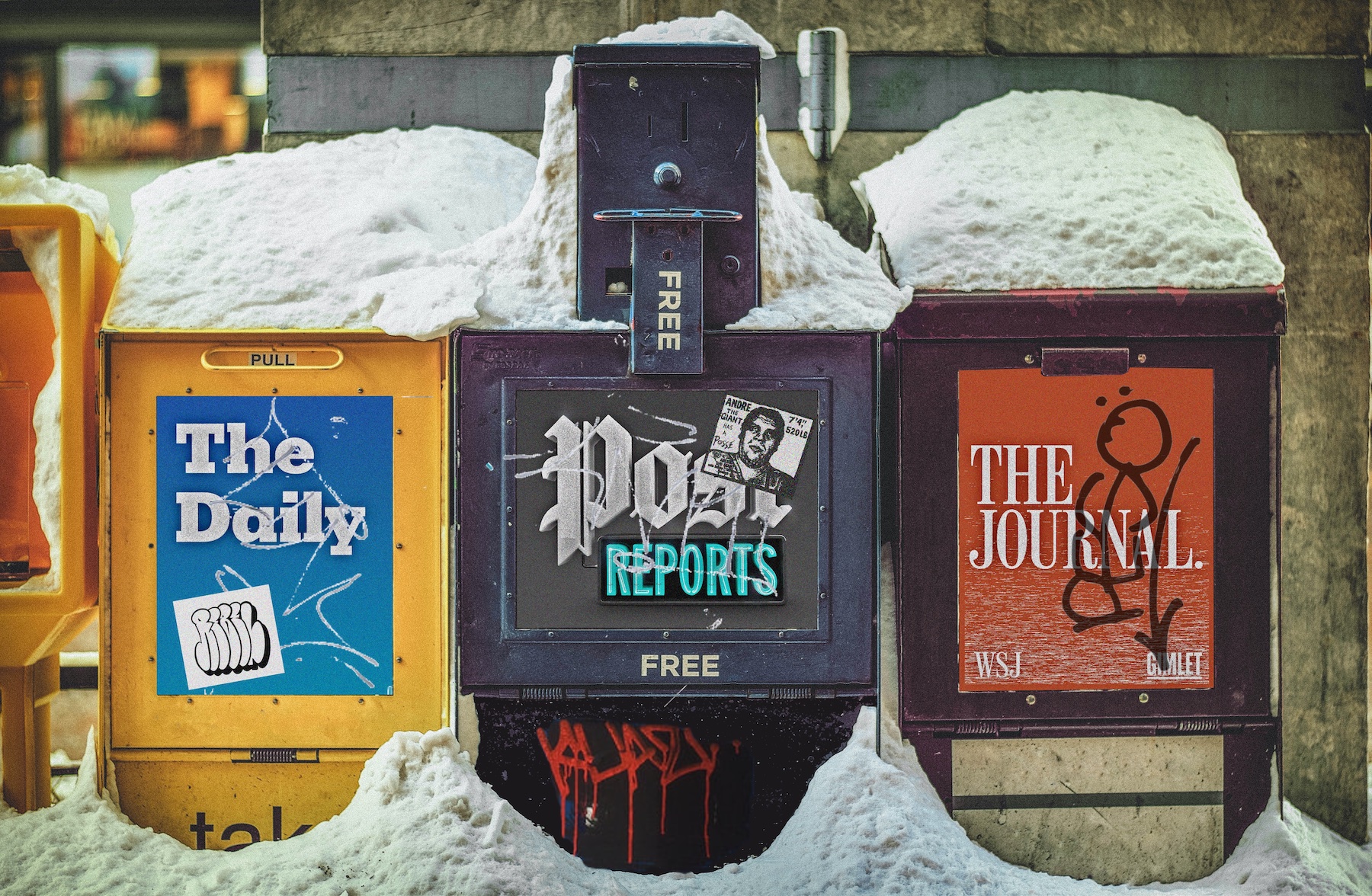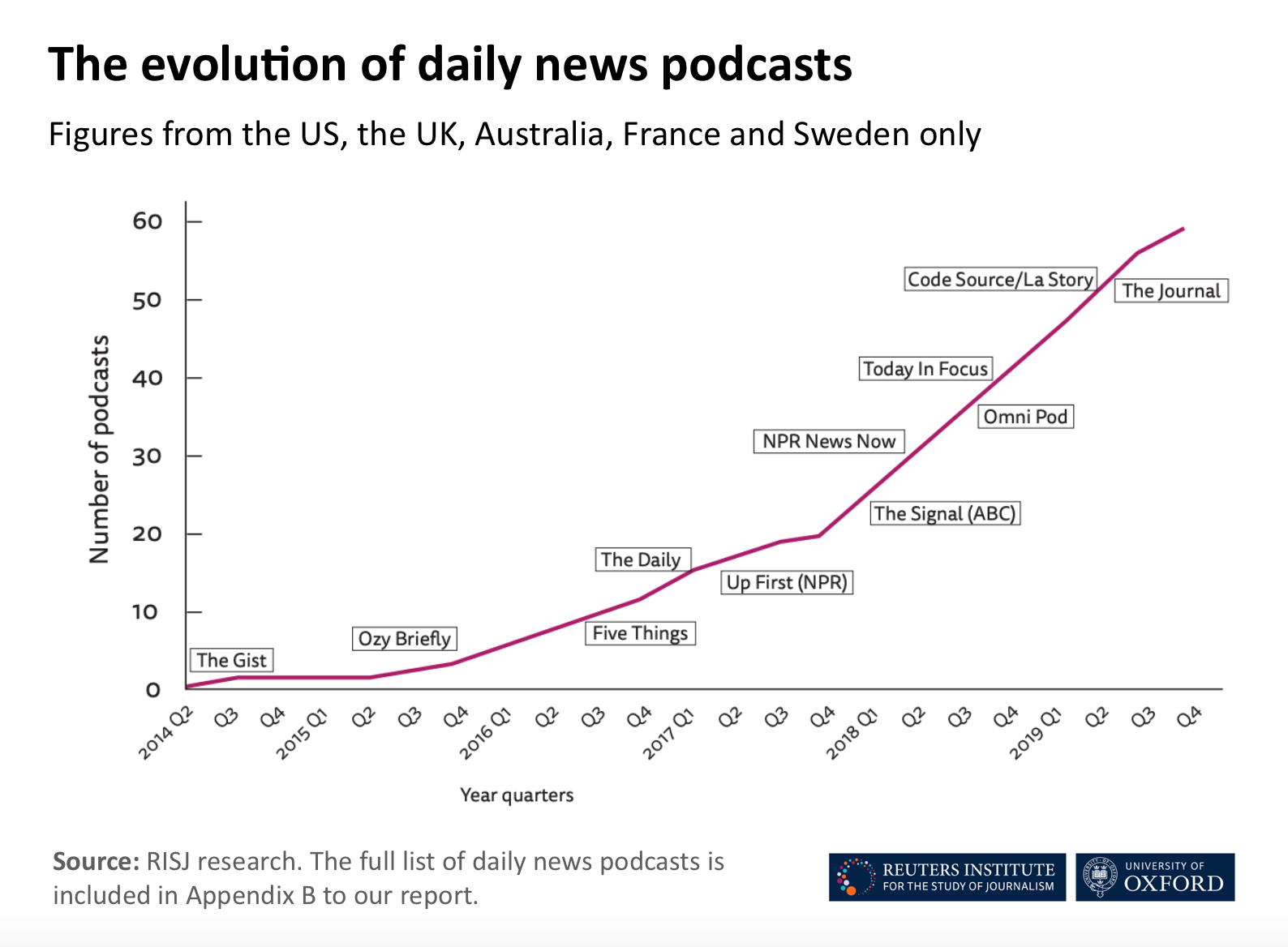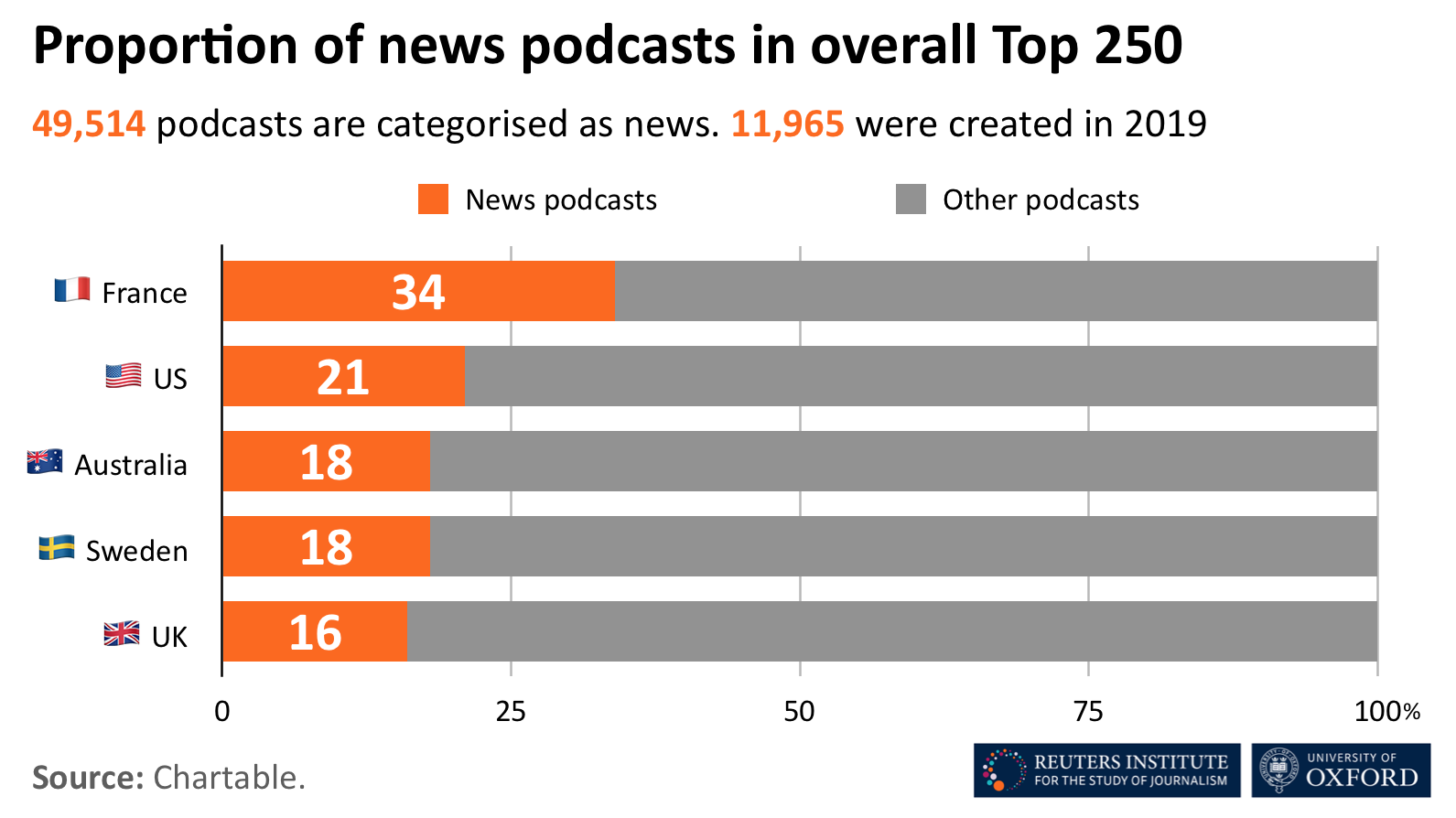
More than 15 years after the term was first coined, podcasting has become one of the hottest topics in media. Our Reuters Institute Digital News Report shows that podcasting is now a worldwide phenomenon: Across 38 countries surveyed, 36 percent said they had listened to a podcast at least once a month, and about 15 percent said they listen to a news podcast. Edison Research estimates that around 90 million people listen to podcasts each month in the United States — a number that’s doubled since 2015. In the U.K., podcast usage is up 40 percent in the past year, driven by a younger generation looking for information, entertainment, and distraction.
There’s been much written about podcasts in general — but less about news podcasts and the creative and commercial opportunities for publishers. That’s the focus of my new research (with Nathan Gallo), using podcast production data from five markets (U.K., U.S., Australia, France, and Sweden) along with interviews with around 30 leading publishers and broadcasters.
One striking finding: the impressive performance of daily news podcasts, most of which have only launched in the past 18 months. The segment leader, The New York Times’ The Daily, has an audience of around 2 million people a day and appears at the top of Podtrac’s October podcast ranking, just ahead of NPR’s rival Up First. “We are thrilled to have 25 minutes a day with people that we didn’t have before,” says Erik Borenstein, director of audio at The New York Times (and a former Knight-Nieman Visiting Fellow). “We really think of The Daily as the new front page.”
Meanwhile, data from The Economist shows that The Intelligence, which is less than a year old, reaches 1.5 million people each month, with the average listener downloading three to four episodes each week. These are substantial audiences, even if they are not yet on a par with the most popular radio news shows in the U.S.
In the U.K., numbers are smaller but still substantial. In less than a year, The Guardian has built a bigger audience for its Today in Focus podcast than it has for its print newspaper. “It’s hundreds of thousands every day,” says The Guardian’s head of audio Christian Bennett, who notes that the podcast attracts a younger audience and features an 80 percent completion rate.
Our research found 60 different native news podcasts across our five countries (excluding daily catch-up radio shows), with many publishers telling us they were inspired by the success of The Daily. Le Parisien and Les Echos in France (Code Source and La Story respectively), Aftonbladet Daily in Sweden, The Guardian’s Today in Focus, and Schwartz Media’s 7am in Australia all follow a similar “one big story” format aimed at morning commuters. Other podcasts take a different approach with a wider mix of stories, such as Post Reports from The Washington Post and The Leader from the Evening Standard, both aimed at the early evening.

Publishers are making significant investments in news podcasts, hoping to attract younger audiences, build audience habits, and bring in additional revenue. Publishers say that blue-chip advertisers are now showing strong interest in podcasts, changing the economics. “There has been so much demand for sponsorship that it more than pays for itself,” said Tom Standage, who helped make the case for The Economist’s daily news podcast. “The big change is commercial, which is that we had advertisers who started to come to us last year and say, ‘We are only going to buy two kinds of ad next year, print and podcast. What have you got?'” But this optimism is not reflected in European markets like France or Sweden, where audiences are smaller and the ad market is not yet fully developed.
The New York Times employs around 15 dedicated people on The Daily. The Guardian employs 10 for Today in Focus and The Economist eight. At the other end of the scale, Schwartz Media, Le Parisien, and Les Echos each produce their daily podcasts with four or five — a more typical number for smaller publications starting out. The skillset tends to include one or two hosts, an executive producer, one or two producers, and a sound engineer/sound designer.
But news podcasts aren’t all about deep dives into a single story. Our research identified three sub-categories of daily news podcasts:

Our report finds publishers from print or digital-born backgrounds focusing more on deep dives, playing to their strengths in analysis and explanation. By contrast, many broadcasters have focused on producing micro-bulletins and redistributing existing radio news programs as podcasts. Where they have commissioned digital-born podcasts, they’ve often been aimed at younger and more diverse audiences that they find hard to reach through linear channels.
Outside daily news podcasts, we found publishers pursuing unscripted talk and interview formats. A number of the most successful are personality-led, such as The Ezra Klein Show (Vox) and Giles Coren Has No Idea (The Times of London). These are often relatively cheap to produce and reuse existing newsroom talent. By contrast, radio broadcasters have looked to leverage their skills in documentaries and audio production by creating one-off series. All the main broadcasters of the countries studied have invested in serialized podcasts. These include Death In Ice Valley — a true-crime podcast produced by the BBC and Norway’s NRK — and Russia If You’re Listening, a landmark series from the Australian Broadcasting Corporation about the Mueller Report and Russian interference in democracies.

News podcasts make up only a small share of all podcasts — 6 percent, as Apple categorizes the 770,000 in its catalog — but the general appeal and stickiness of news content mean that the category outperforms other types of content in terms of consumption. News makes up 21 percent of the most popular episodes in the United States’ Apple Podcasts charts, according to the analytics company Chartable. It’s a similar picture in other countries, with 34 percent of the top podcast episodes in France categorized, as well as 18 percent in Sweden and Australia and 16 pertcent in the U.K. Across all genres, the number of new podcasts is growing at a rate of more than 200,000 a year, though that growth has started to slow a little.

New platforms are shaking up the podcast market, bringing new ideas and extra investment. Apple still accounts for the majority of podcast use, but music services are helping to popularise content, with Spotify doubling its market share in the past year. A number of podcast-specific paid content providers are commissioning original content and offering significant sums for the production of exclusive content. This opens up new opportunities for publishers around comedy, sport, lifestyle, and high-quality narrative series. In the United States, new platforms like Luminary and Stitcher Premium are trying to build a new business model based on premium subscriptions, while in Europe, we’re seeing the emergence of new services like Majelan and Sybel in France, or Podimo in Denmark. All these actors have the ambition to become a “Netflix of podcasting” as they invest in original audio content and try to bring podcasting to a wider public.
But the growing influence of tech companies and other intermediaries is bringing familiar challenges. Many publishers fear they are helping platforms build profitable businesses on the back of their content. Others worry they could lose their direct relationship with audiences, including first-party data, as platforms take the credit for content. Public broadcasters in particular are trying to develop their own destinations for audio content, and a number have started to publish first to their own platforms or are withholding content from third parties altogether.
Most publishers feel there’s still significant room for growth, with new voice-driven interfaces making it easier to access on-demand audio in the home and on the move. But the scale of the opportunity remains unclear, with revenue still relatively modest and increasing competition from platforms and independent producers. Podcasting is attracting younger audiences, but predominantly from the better-educated “latte-drinking” classes. Reaching more mainstream audiences will require a broader range of content and audio formats, better interfaces, and improved distribution. These changes are likely to take some time.
Nic Newman is a senior research associate at the Reuters Institute for the Study of Journalism.